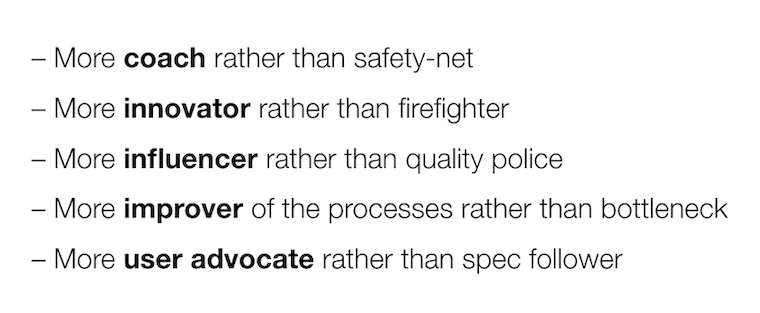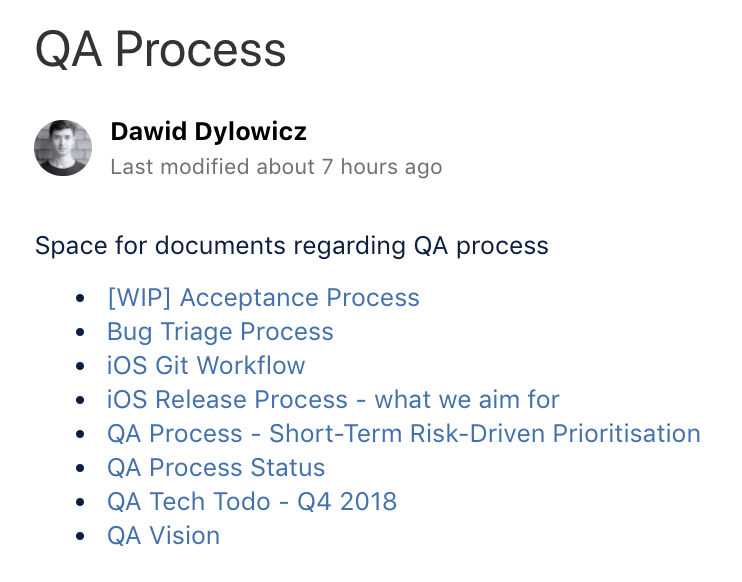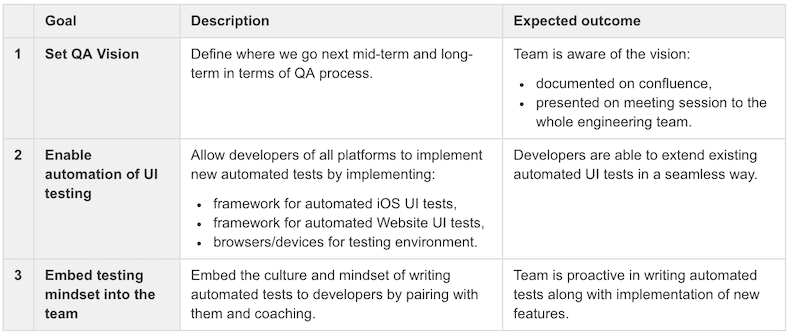First month as a QA Lead in a startup — 6 pieces of advice

This article is the 4th part of a 5-article series about joining a startup as a QA Lead.
In the previous article, I wrote about 5 things to do in the first week. This time I want to zoom out and tell you about what to focus on in the first month as a QA Lead in a startup.
Imagine this: after one month, you are already a well-recognised part of the team. You have proven your attitude, your skills and your character. You have shown your work and you are respected for your contribution. People are keen to help you achieve your vision and they support you by executing testing tasks.
Isn’t this a QA Lead heaven?
Below I listed 6 equally important pieces of advice which will help you shape your leadership position and realise that vision.
Let’s take a look.
Define your role
One thing is clear: you’re the QA Lead here — no one else.
But what does that role really stand for? Well, this time you have to figure it out by yourself. You need to get it clear in your mind first. It would massively help if you prepared for the leadership role.
However, the vision living in your head is not enough to completely shape your role in a new job. You have to consider what expectations are put on you as well. I advise you to find out how your manager imagines your responsibilities. You can go even further and ask some engineers how they imagine the QA role as well.
The truth is, this role can be defined in many ways. Especially in a startup, where you’ll likely play many roles. It might be wide to the extent that it gets blurry what your responsibilities are — especially when you’re the first QA. So don’t expect yourself to find out everything in a day or so. It may take some time.
Defining your role is not something that comes purely from you, though. It’s composed of your vision, the expectations of others and the environment you’re in.
Once you sort it out, however, don’t wait anymore and communicate to the team what your responsibilities are and what you’ll be taking care of. Make sure you all agree on that.
For example, I put together a presentation and shared how I see my modern QA role with the team. Here is a part of it:

Work on the QA culture
This is, I believe, the hardest part.
Why? Because the QA culture is impossible to be introduced by just one person. It’s a set of behaviours that all the people in your team have to adopt. You can’t control the implementation.
However, there’s something in your control. You can initiate it. You can influence it. You can drive it. And since you’re the QA Lead — you’re in the best position to do so. That’s why I used ‘work’ verb in the title of this section — because it’s a process of constant work on the culture.
How can you do it? I can’t tell you what exactly will work in your case because every team is different. But I will try to help you by sharing some practices that I started introducing to the team myself.
Firstly, you need to have a vision of how the QA culture can grow in the team. You need to lead that vision but always be ready to react if something doesn’t work as expected. You can’t fully control the way it will evolve, but you can fully control your reaction.
Secondly, the vision of the QA culture should be based on a combination of what you feel is best for the team, what the team is capable of, what the current mindset is and what your personal QA beliefs are as well.
Thirdly, you cannot just tell everyone: “We test this and that and that’s it.”. You have to lead them through logical reasoning they can follow and understand. Then you have to show why it may work.
Culture is a common set of behaviours. You might be driving the bus but you need everyone willing to go in the same direction. Otherwise, you’ll be driving an empty bus.
Let me give you an example.
I’m a big fan of Modern Testing Principles and I based my QA culture vision on them. These principles may sound radical from traditional QA point of view — especially to developers. At the same time, I’m against sudden changes, because rejection is often the first reaction. I prefer doing things step by step. This is why I started with presenting the QA culture vision to the team and opened up a discussion.
To my surprise, the reception was positive. I got asked a few questions but these were not aimed to challenge the idea, but to reassure that we were on the same page.
Why did it work so well? I bet on two things. First, I work with open-minded people who are not afraid of trying out new things. Second, I’ve built good relationships with them and they trust me.
So does it mean the culture has been all set? Not at all. For now, we just sowed a seed that we have to water every day.
So I recommend you to think of the best way that can work for your team. If you try and it doesn’t work — learn why and adapt quickly.
Execute short-term, think long-term
Here I refer to the short-term vision that I wrote about in the previous article, highlighting it as the most important task that you have to do in the first week.
So during the first month, you should focus on executing that vision. Whatever you defined there — now is the time to do it.
At the same time, however, you should start looking into the future. Envision how you want the QA process to look like in your organisation. Since it’s about recognising what should be done next — let’s face it — it’s not an easy task.
It depends on many factors, such as the priorities in your organisation, the mindset in the team, and the potential risks associated with people, technology, customers and product.
Hence I advise you to start focusing on the process, rather than the results.
Again, there are no silver bullets. But you can always get a shotgun. Here’s one:
- What are the biggest risks you have to tackle next?
- How do you see the QA process in the team in 6 months?
- How do you see the function of the QA team?
- How do you see your role?
- How can others help you achieve that?
Answering these questions should make shaping that long-term vision much easier for you.
Support the team
In the first month, you have to make sure the team can rely on you and they trust you.
This is because you’re going to benefit from that — more on that soon.
To support the team, you have to reassure them that you actually can do it. Show your attitude, show that you deeply care, show that you’re there to help. Listen to their problems, analyse them and try to find solutions. Be open to give a hand whenever asked. If you don’t have time at the moment — just admit it and say when you will likely be able to help.
As a QA Lead, supporting the team is one of your main responsibilities.
Put yourself in the loop of observing, giving feedback and improving. By the end of the first month, you should already notice what’s working well and what’s not. The best time to flag these things up is a retrospective meeting. If they’re not part of the culture yet — introduce them. Every two weeks is a good schedule.
Remember that the goal of the retrospective is to highlight things that work well, things that could be improved and any other ideas. Celebrate the good things but put the most focus on things that can be done better, then create actionable task and make sure it’s assigned to someone. It’s a good practice to keep track of these things and review them at the beginning of the next session.
Ok, so how will you benefit from this? Now I can tell you: Support the team…
Delegate testing tasks
…so they can support you, too.
Even if you’re the only QA in the team, it doesn’t mean you have to do everything by yourself.
Once the team knows they can count on you and they understand your vision of the QA culture, they’ll likely help you achieve that.
So don’t try to do everything on your own. In the startup world — or should I rather say — in the Agile world, it’s about we, not I. Use the power of the whole-team approach and delegate some testing tasks. You’ll be surprised what the team members can do with them.
This can be defined as part of the QA culture, but even if you don’t explicitly specify it, nothing is stopping you from leveraging delegation. However, it might be worth informing everyone upfront that you’re going to do it.
There’s a risk that you may face some objections. It’s not that people don’t want to help you — they may just get frustrated when they don’t understand the importance of testing or they don’t know how to perform it. One of the reasons might be that they haven’t done it yet. This is why supporting the team members and building relationships proactively is such an important responsibility of your role.
What should you do? Empower others to test efficiently. For instance, you can pair with each team member and go through the first testing task together. This way you enable others to contribute to the improvements that you initiated.
Finally, remember that you’re in charge of starting and making the QA machine work. But at some point you’ll need to ask others to help you keep it going. And you better prepare everyone for that or else you’ll soon become the bottleneck of the team.
Show your work
Last but not least, you need to show your work.
Why is it important? Your work as a QA might be hardly visible at times, so it’s crucial to proactively share your results with the team. When you show your work, you make things transparent and visible to everyone. You build trust not only in the team but also in yourself.
To do that, I recommend you to simply keep track of:
- things you’re planning,
- things you’re doing,
- things you’ve achieved.
Showing your work is so little but yet so much that you can do.
If you want to see an example, here’s the QA knowledge space where I keep documentation of all projects and their outcomes:

Also, I encourage you to go one step further and set personal goals for yourself. Whether or not there’s a performance review process in place, think of 2–3 things that you want to achieve this quarter and write them down. It’s best if you define goals that not only help you grow professionally but also contribute to the success of the team.
Then you can regularly share your progress with your manager on 1-on-1 meetings. You’ll not only show your work but you’ll also keep yourself focused on the right things. And when stuck, your manager will be able to help you get through.
Be humble, however, and know where the line is. Don’t boast, don’t show your ego — simply show your work.
Finally, here are my personal goals for this quarter:

And here we are with 6 things that I recommend you to do in the first month as a QA Lead in a startup. Let’s sum it up:
- Define your role
- Work on the QA Culture
- Execute short-term, think long-term
- Support the team
- Delegate testing tasks
- Show your work
In the final part, I will tell you about what I’ve learned after 30 days as a QA Lead in a startup.